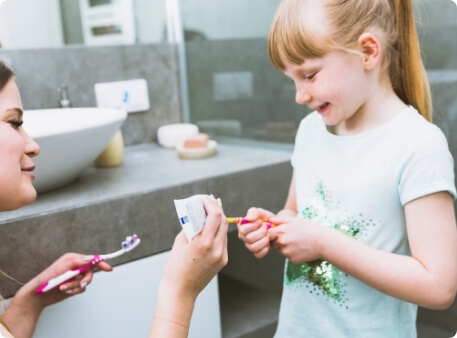Our Top 10 Tips for Healthy Teeth in Children

Here are our top 10 tips for healthy teeth in children:
1. Maintain a great diet and oral health routine yourself!
Children are observational learners. They imitate the behaviours of those around them, especially the adults in their lives! Following a nutritious diet and keeping your teeth and gums healthy will set your child’s dietary and oral health habits up for a lifetime! Dental decay is also infectious; the bacteria that causes dental decay can be spread from adults to children by kissing and sharing food, utensils and toothbrushes. The best way to ensure children have healthy, decay-fee teeth is to ensure that your teeth and gums are healthy first!
2. Encourage a healthy diet!
Promote a healthy diet containing teeth-strengthening food and drinks such as water, crunchy fruit and vegetables, milk, cheese, unsweetened yogurt, nuts, seeds, eggs and lean meats. Limit the intake of sugary and acidic drinks such as fruit juices, flavoured milk, soft drinks, sports drinks and cordials. Water should be the drink of choice for children (and adults!) as fluoride in water protects teeth and prevents tooth decay! The consumption of sugary, sticky and chewy foods, including lollies, toffees, chocolates, cakes, cookies, roll-ups and sugary cereal bars, should be limited and switched with healthier alternatives when possible.
3. Ensure you only fill baby bottles and sippy cups with unflavoured milk and water!
Putting cordial, soft drinks, fruit juices, sports drinks, and flavoured milk in baby bottles and sippy cups makes sugar sit on the teeth longer than it does when drinking from a cup, causing teeth to decay faster.
4. Encourage tooth brushing twice a day for two minutes!
Make tooth brushing a part of a child’s daily routine and make it as fun as possible by playing their favourite song for 2 minutes while they brush. This creates a fun and positive environment that children can look forward to in the morning and before bed. Brushing before you go to sleep is especially important as your mouth decreases saliva production while you sleep. Saliva plays an important role in protecting against tooth decay. Teeth are most at risk of tooth decay while you are sleeping, so leaving plaque, food buildup and bacteria on your teeth overnight is detrimental to the health of your teeth.
5. Look for early signs of tooth decay in your child’s mouth!
The most common place for tooth decay in children is along the gum line on the upper teeth; this is a spot children often miss when brushing. White spots may be present on the tooth along the gum line- an early stage of tooth decay that is reversible with fluoride. There may also be dark spots or holes- an irreversible and late sign of tooth decay. Seek dental advice and treatment if you spot any of these signs.
6. Regular dental check-ups!
Ensure your child attends regular dental check-ups at an early age to familiarise them with the dental setting and help them feel comfortable with dental visits. Early screening and preventative measures taken at regular dental appointments ensure minor dental problems can be found and treated before they turn into big ones! Prevention is always better than cure!
7. Limit thumb-sucking and dummy use!
Prolonged thumb sucking or dummy use can alter the shape of the face and push teeth out of alignment. This can result in breathing issues as well as severe orthodontic issues. If you are worried about your child’s thumb-sucking or dummy use causing dental problems, speak to your dental professional.
8. Use fluoride toothpaste!
Fluoride toothpaste can and should be used for children when they are 18 months old or earlier if recommended by a dental professional. Fluoride prevents tooth decay and helps to regrow tooth structure lost in the early stages of tooth decay. Fluoride also strengthens teeth and makes them more resistant to the acids produced after eating and drinking. Use a pea-sized amount of toothpaste recommended for your child’s age. Adult-strength toothpaste should only be used for a child if recommended by a dental professional. After brushing, encourage children to spit out excess toothpaste but don’t rinse with water after brushing! Rinsing with water after brushing gets rid of the great benefits of toothpaste!
9. Floss!
Flossing can be implemented in a child’s routine as soon as two teeth start to touch. Flossing is essential as a toothbrush can not always adequately remove plaque from between teeth. Seek advice from your dental professional for the best and easiest way to floss your child’s teeth!
10. Ask a dental professional if fissure sealants would benefit your child!
Chewing surfaces of back teeth have pits and grooves (fissures) that trap food and bacteria and can be difficult to clean, often leading to tooth decay. Fissure sealants are a white or clear coating that can be painted on these surfaces like a layer of nail polish to act as a protective barrier against tooth decay, strengthen the teeth and make these surfaces much easier to clean.





